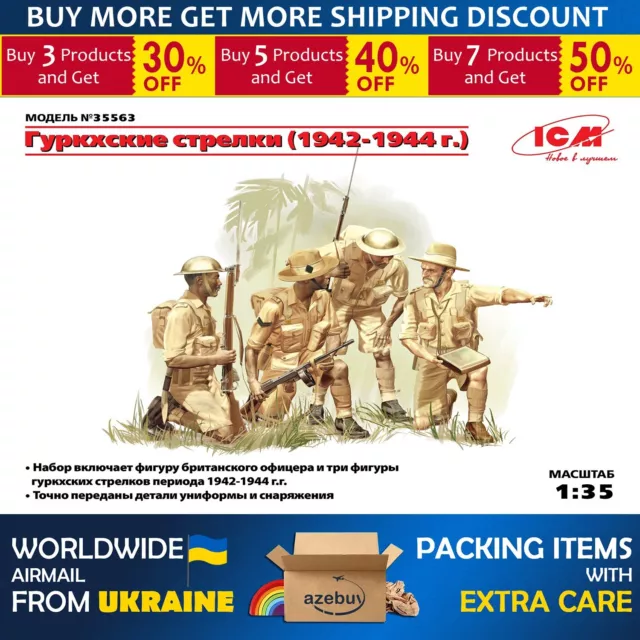Gurkha Rifles (1942-1944) World War II 1/35 Scale Plastic Model Kit ICM 35563
U & azebuy
Shop of toys and models from Ukraine
DESCRIPTION
from Ukraine
DESCRIPTION
Gurkha Rifles (1942-1944) World War II Plastic Model Kit
ICM 35563
1:35 Scale
Manufacturer: ICM
Material: Plastic
Condition: New in original packaging
Historical reference
For the first time, rifle units as a branch of the military appear in British North America in 1756 with the formation of the 62nd American Royal Infantry Regiment (since 1757 the regiment's numbering was changed to 60th), recruited from local colonists and foreign officers to protect against French troops. The main task of the newly created regiment was to more effectively conduct hostilities in wooded areas.
Combining line battalions in an open forest area and the work of shooters in a closed forest space with salvo and change of fire gave its first results and thanks to such tactics, the effect was achieved in this natural area. After 1797, due to tactical tasks, the regiment was armed with only rifles, and it completely departed from linear tactics.
In 1800, a second British infantry formation, known as the Experimental Rifle Corps, appears, this time armed with new and improved Baker rifles. Shooting tactics were carried out in pairs (one kneeling, the other lying) and often from behind cover. In fact, these units can be compared to modern snipers. Other innovations also appeared, in particular, the transmission of commands did not take place with the help of drum rolls (as in linear shelves), but with the help of the sound of a horn (bugle). Another color of uniforms was also introduced: instead of the usual red, protective green appeared. In everyday life, soldiers could eat at the same table with officers, and corporal punishment practically disappeared (these innovations also affected the 60th regiment). A distinctive feature of the newly created formation from other infantry regiments was, first of all, in the fact that, in addition to line battalions, a unit of a new type appeared in it - shooters, whose battle tactics were based not on firing from a closed line formation on command, but on a chaotic formation and variable shooting. The armament of the shooters also differed from the line regiments: instead of the usual Brown Bess musket, German-style rifles with more accurate and long-range shooting were purchased (the action of the musket was more effective for a closed formation due to its powerful penetrating ability and fast reloading).
The first good results of the corps were shown during the amphibious assault of the British on the city of Ferrol in Spain, where the arrows accurately shot down the defenders of the city from its heights.
In 1803, the corps was transformed into the 95th Rifle (Infantry) Regiment, and on February 23, 1816, it was renamed the Rifle Brigade. Subsequently, the title of "Prince Consort's Own Rifle Brigade" (husband of Queen Victoria) was added to the unit. In 1815, the 60th Rifle Regiment also changed its name to the Duke of York's Own Rifle Corps, and in 1830 to the King's Royal Rifle Corps. In terms of their functions, the rifle units were close to the light infantry units (appeared in 1803), but were not formally included in them. Since 1859, other irregular rifle formations have appeared in large numbers, consisting of volunteers (volunteers), both on foot and on horseback (horse formations made up only one two hundredth of the total number of rifle units).
Soldier and Officer of the Royal Rifle Corps, 1895-1914
In 1860, a rifle battalion consisting of the militia was formed in Canada. In 1881, two more new rifle divisions appeared, belonging to the regular units: the foot regiment of the Cameron Rifles (Scottish Rifles) and the Royal Irish Rifles. Later, other rifle units were created, although after the end of World War II, this pace slowed down due to the decrease in the number of the British armed forces, which in turn was associated with the decolonization of the territory of the British Empire.
In 1948 the Rifle Brigade and the Royal Rifle Corps were merged into one unit called the Green Jackets. In 1958, the 1st Battalion of the Green Jacket Brigade was reorganized from the Oxfordshire and Buckinghamshire Light Infantry Regiments (abbreviated as Ox and Bucks) as the newly formed infantry unit of the British Army. The 2nd and 3rd Battalions on this list were occupied by the Rifle Brigade and the Royal Rifle Corps, respectively.
In 1966, the Green Jackets Brigade was reorganized into a regiment and received the royal prefix Royal (Royal Green Jackets). At the same time, two other new battalions (No. 4 and No. 5), reformed from the riflemen of the Territorial Army and its light infantry, entered the same place. In 1994, as a result of the merger of four Gurkha rifle regiments, one common rifle regiment of the British Army was formed with the prefix Royal (Royal Gurkha Rifles), which still exists today (but is not part of the Rifles regiment). In 2007, after lengthy reorganizations, the Royal Green Jackets regiment was merged with the three
Результати перекладуThe first robots from the leg of the "Tiger" reigned in 1938. Until the moment, there were no important tanks on the Wehrmacht, similar to those of the Radiansk T-35 or French Char B1. On the other hand, in the planning of the new doctrine (vyprobuvanіy pіznіshe in Poland and France), it is practically not a problem for important, low-deteriorating cars, so we can help those who are so kind of a tank to reach this kind of tank. Tim is no less, Erwin Aders, one of the leading designers of the company "Henschel", who hailed the project of a 30-ton "tank to cut through" (Durchbruchwagen). Stretching 1939-1941 rr. Firma "Henschel" had two previous experiences, from the designated DW1 and DW2. The first of the prototypes was not maw bashty, the other was installed basta from the serial PzKpfw IV. Tovschina armored prototypes did not perevischuval 50 mm.
With the invasion of the Third Reich at the Radiansky Union, it became obvious that the Wehrmacht's tank fleet needed to be able to make the tank more powerful. Nice medium tank Panzer IV Ausf. E-F signifiedly sacrificing for the main characteristics of the Radiansk medium tank (in the Nimetsky classifications of the quiet rockies of the Mittlererschwerer - medium-important) T-34 sp. 1941. The Wehrmacht did not have an analogue of the KV-1. Hoca for rakhunok visokoї maysternostі ekіpazhіv, good nasichennya Tank Chastain artilerієyu suprovodu, vіdmіnnoї vzaєmodії of avіatsієyu nіmetskі vіyska bіlsh nіzh uspіshno vivodili of harmony Yak T-34, so i HF, in znachnіy kіlkostі boyovih epіzodіv at the hands of literacy Radyans'ka tankіstіv tridtsyatchetvіrki i HF naochno shown , it’s a good look, the change in ergonomics still doesn’t compensate for the poorer armor and health of the Panzer IV Ausf. E-F. In the midst of chaos and rogue in the Radiansk command, the cars became more threatening for the soldiers of the Wehrmacht. In addition, in the course of the battle, the nimetsy vіyskami were often told to stick out because of the advance prepared by the enemy’s defense, because the need for an important tank wasn’t going to get lost. The solution of the emerging buildings was divided into two straight lines - the modernization of the already existing armored vehicles (Panzer III and Panzer IV) and the acceleration of its analogue of the Radiansky KV-1.
In an unprecedented attempt to attack the SRCP by the design bureau of two types of car and car companies - "Henschel" and "Porsche" - tactical and technical vimogi were sent for an important tank to cut the design weight of 45 tons. The ordered head of the first design bureau, Yervin Aders, also had a significant baggage for DW1 and DW2, and for Ferdinand Porsche, he got away with his rivals, just having tried himself in tanks. The presentation of the previous images was assigned to the day of the Fuhrer's People's Day - April 20, 1942, to the rock, an hour to release and induce prototypes of bulo nebagato. Yervin Aders and the sportsmen of the 1st design bureau went on the traditional path of the German tank-training school, vibrating for a new important tank the same layout as that of the Panzer IV, having stuck on the tank the new "mine leader" of the designer G. Kn_pka Prior to that, it was stagnant only on tractors and armored personnel carriers of the company "Ganomag", the victorian for the tank became a novelty for the new tank. With such a rank, it was successfully achieved to improve the smoothness of the ride, and also to improve the accuracy of the shooting on the go. Ferdinand Porsche, who at that time saw innovative robots in a car (including a sports car), trying to move his pidhid to a new one. On the first prototype, there have been realized such solutions, as highly effective later torsion in the systems of drive and electrical transmission. However, at the time of the prototype of the company "Henschel", the car of F. Porsche was structurally foldable and vimagal of more scarce materials, a zokrem midi. A bashta appeared on the last building in the distance, yaku, without any special changes, “competition” appeared.
Following the results of the demonstration of prototypes to the Fuhrer and the upcoming tests at the Kummersdorf polygon, the third Reich's capital was taken by the prototype of the company "Henschel", unaffected by the intercessor of Fuhrer F. Porsche. On the name of the PzKpfw VI Ausf. H "Tiger" for launches in the middle of the world. The total number of cars produced is 1355 units. Payment Policy
We accept only PayPal
Shipping Policy
We ship WORLDWIDE .
We will ship your purchase to your eBay address using AIRMAIL with TRACKING NUMBER . Usually we ship the items the same or the next day after the payment is fully received. The parcel will leave our country (Ukraine) directly from our town (Kiev) without waiting local delivery inside country.
All the discounts are given by request.
Average delivery time is 7 - 15 BUSINESS DAYS .
Returns policy
If you did not receive your package within the estimated date as stated in our shipping terms, we'll contact the post office and let you know the whereabouts of your package and assure to refund you 100% if the package is lost.
Always make sure contact us before opening a dispute/case or leaving a negative/neutral feedback.
As always, your satisfaction is very important to us.
FEEDBACK
The satisfaction of all our customers is very important for us, so we are waiting for your feedbacks after the delivery.
If something is wrong, please, contact us before leaving the negative feedback and we will no doubt settle all the cases.
Contact Us
We respond to most messages within few hours and all within 24 hours. We are here to assist you. Message us for all questions you have.
With love from Ukraine
2017 - uazebuy- Condition: New
- Unit of Sale: Single Unit
- Assembly Status: Unassembled Kit
- Color: Gray
- Scale: 1:35
- Set Includes: Figure
- Material: Plastic
- Year Manufactured: 2023
- MPN: ICM 35563, ICM35563, 35563
- Age Level: 12-16 Years
- Subject: Gurkha Rifles
- Vintage: No
- Brand: ICM
- Type: Figure
- Unit Type: Unit
- Customized: No
- Skill Level: 2 – Easy
- Model: Gurkha Rifles (1942-1944)
- Theme: Militaria
- Country/Region of Manufacture: Ukraine
- UPC: 4823044403424
PicClick Insights - Gurkha Rifles (1942-1944) World War II 1/35 Scale Plastic Model Kit ICM 35563 PicClick Exclusive
- Popularity - 2 watchers, 0.0 new watchers per day, 1,132 days for sale on eBay. Good amount watching. 0 sold, 5 available.
- Best Price -
- Seller - 6,391+ items sold. 0.8% negative feedback. Great seller with very good positive feedback and over 50 ratings.
People Also Loved PicClick Exclusive

German Patrol (1939-1942) World War II 1/35 Scale Plastic Model Kit ICM 35561
$19.92 Buy It Now 24d 22h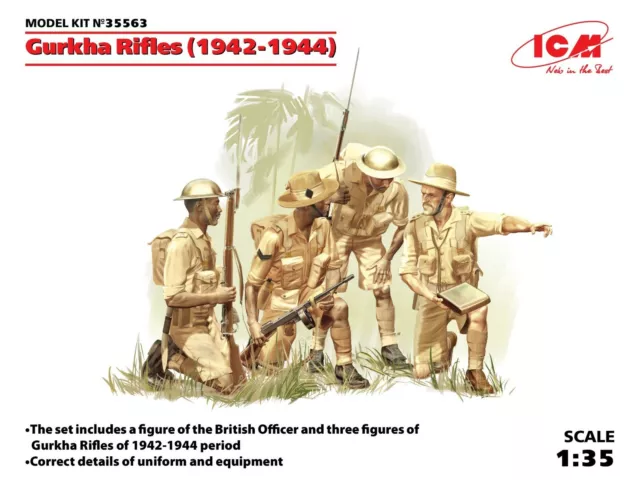
Gurkha Rifles (1942-1944) 4 Figures w/ Equipment (Model kit) 1/35 ICM 35563
$11.80 Buy It Now 26d 3h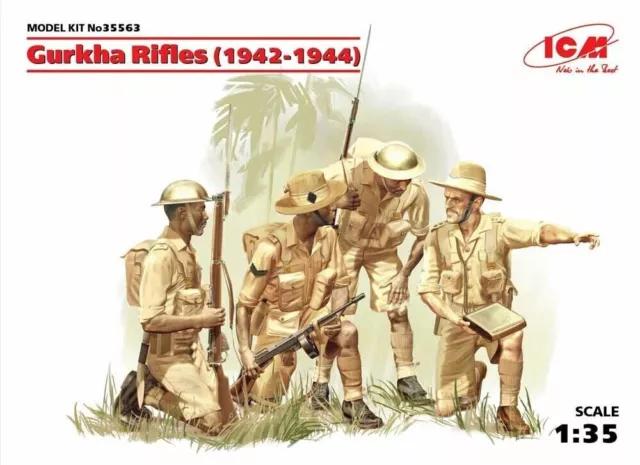
ICM 35563 - 1/35 Gurkha Rifles (1944) (4 figures) Figure Model Kit
$15.56 Buy It Now 30d 5h
Indian Sikh Rifles (1942) World War II 1/35 Scale Plastic Model Kit ICM 35564
$19.92 Buy It Now 24d 23h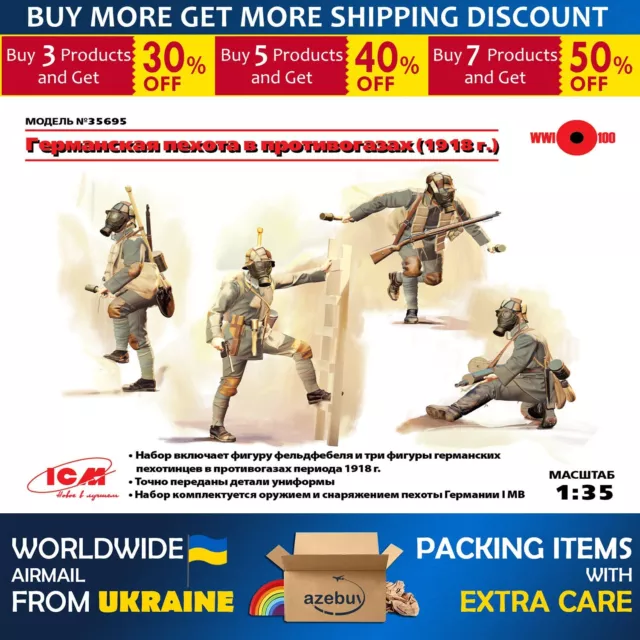
German Infantry in Gas Masks 1918 Year WWI 1/35 Scale Plastic Model Kit ICM35695
$20.80 Buy It Now 22h 27m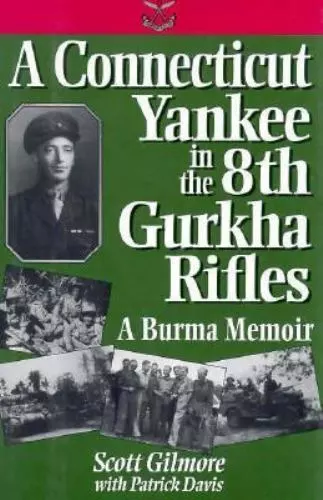
 A Connecticut Yankee in the 8th Gurkha Rifles: A Burma Memoir - ACCEPTABLE$13.54 Buy It Now
A Connecticut Yankee in the 8th Gurkha Rifles: A Burma Memoir - ACCEPTABLE$13.54 Buy It Now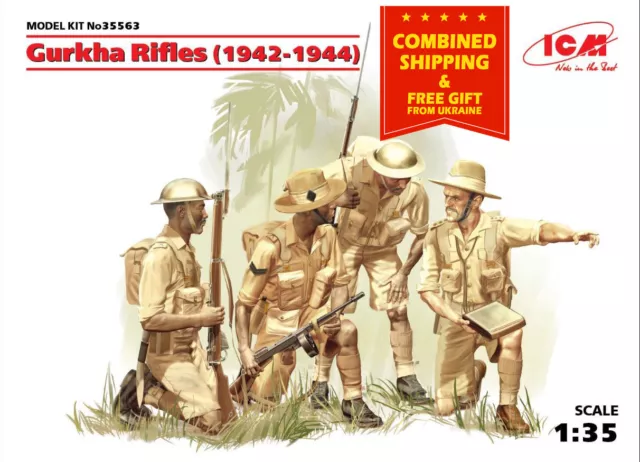 5 watchers
5 watchers ICM 35563 - 1/35 Indian Gurkha Rifles (1942-1944) WWII plastic model kit
ICM 35563 - 1/35 Indian Gurkha Rifles (1942-1944) WWII plastic model kit$35.79$33.28 Buy It Now
A CONNECTICUT YANKEE IN THE 8TH GURKHA RIFLES: A BURMA By Scott Gilmore NEW
$78.42 Buy It Now
The Gurkha Rifles (Men-at-Arms), J.B.R. Nicholson, Good Book
$20.64 Buy It Now
